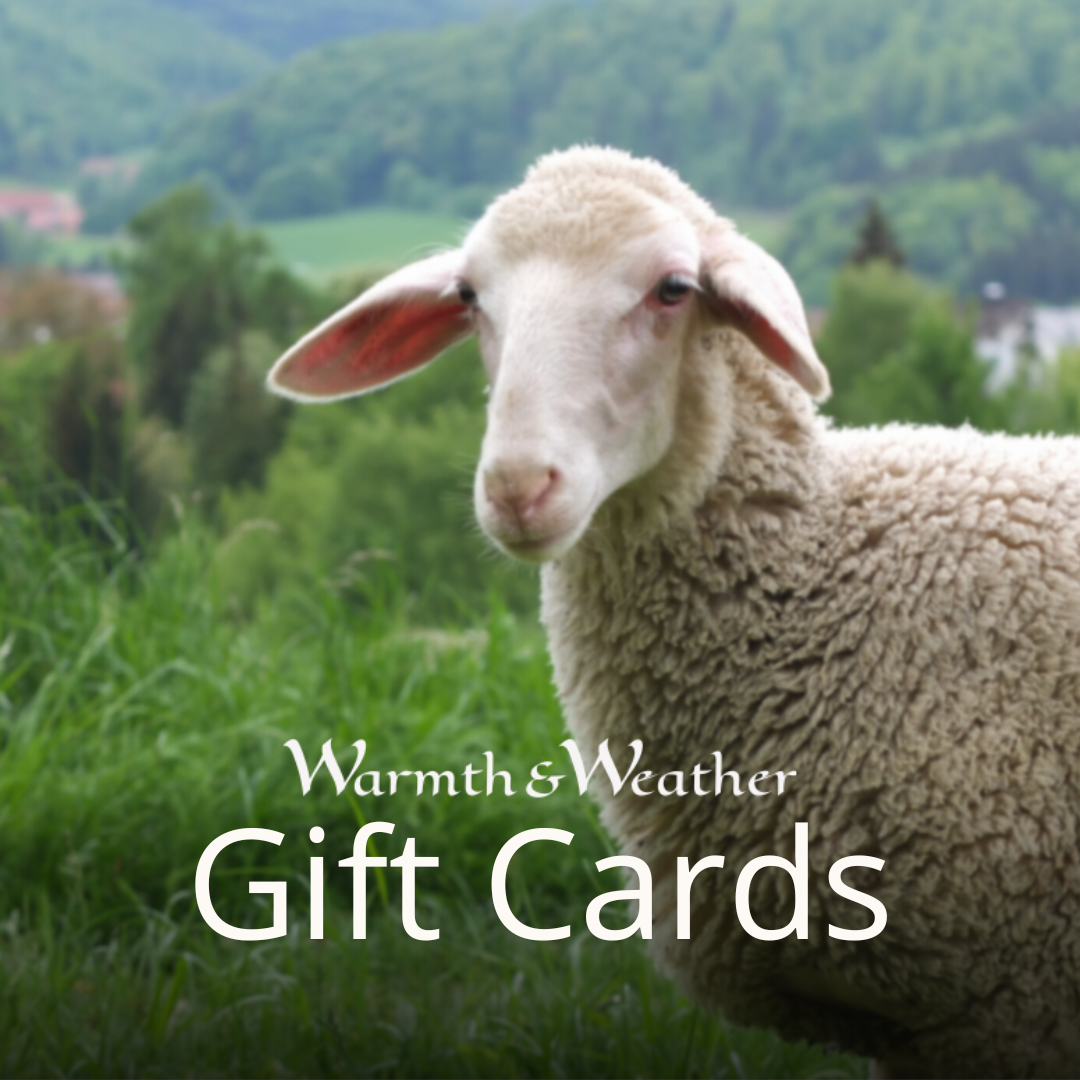
To Feel Merino Wool is to Feel Well
To be dressed in wool, especially next to the skin, brings a natural foundational warmth that supports wellness in life. Living in warmth is essential to human beings and is the primal invisible source out of which life is created. The warmth process weaves unseen within us maintaining our bodies. We live and have our own being of warmth. With warmth we become more human.
Wool for all kinds of Weather
Wool is by nature warm. Wool is natural, hypoallergenic, insulating, temperature regulating, moisture wicking and repellant, odour resistant, self-cleaning and biodegradable.
You might be asking, but won't wool irritate the skin? Scratchiness in wool depends on the type of wool and the length of the strands of wool. Our companies create clothing with the highest quality merino wool. Research shows that a wool allergy is actually quite rare and that a reaction to wool is more likely from a chemical used in the wool. Using organic wool will usually solve the problem.
Wool absorbs up to one third of its own weight in moisture and depending on external conditions, is able to return it to the environment. Synthetic clothes may look the same but do not allow the skin to breathe and accumulates uncomfortable heat and moisture. Cotton does not ‘wick’ away moisture and can result in a cold and clammy feeling next to the skin.It is warmth and moisture-regulating, keeping us warm in the cooler months and cooler in the warmer months. Wool and wool/silk make the most effective base layers.
Unpleasant odour comes from bacteria which develops quickly in the moisture from sweat. Animal fibres, like wool and silk, take up the moisture and wick it away by airing; thus bacteria cannot settle as easily. Crop fibres such as cotton as well as synthetics hold bacteria. Knitted clothing form an insulating air cushion more than woven materials. A natural warmth is generated without heat build-up, regulating humidity, and supporting a healthy skin climate.
Merino Virgin Wool
Merino wool is finely crimped and feels soft and cosy. Wool and silk blends are agreeable even to delicate skin. Wool/silk blends keep their shape to a high degree and show a minimum of shrinking. The proportion of blending can accentuate the characteristics of each of the fibres and provides a comfortable and long-lasting wear experience.
Silk is especially healthy for the skin. Silk actively balances temperature, giving warmth when it is cold and cools down when warm. Silk is suitable for people with sensitive skin. Silk can take up 40 % of its own weight as moisture.
The merino wool used by our clothing manufacturers are from sheep raised in a natural environment and on organic farms. The animals live a healthy and stress-free life. The use of pesticides is forbidden both on pastures and on the animals.
Wool for Babies
Babies need warmth for their developing bodies. It takes up to 9 months for babies to regulate their own body temperature. When they are dressed in warm woolens next to their skin, they feel cozy and can be more content. Woolen bonnets and baby onesies with long johns are the ideal base layer for babies and young children. They can maintain their body temperature, especially if they spend time on the floor. Wool prevents heat and moisture accumulation, which for instance, can be noticed with synthetic clothes or plastic diapers. Wool/silk blends are especially kind to babies with sensitive skin. Silk liners are useful for diaper rashes.
Babies and young children need cozy nightwear as they often do not stay under their covers. Woolen sleeping bags enclose baby with warmth while they sleep.
Care of your Woolens
Wool and silk regenerate in fresh air and do not need to be washed frequently. Wool is dirt resistant and self-cleaning. Spills and dirt sit on the surface and can be easily wiped off. Many woolens need hand washing while the newer merino wool/silk items can be put into the machine on gentle wool cycle with warm water. Check the label for care recommendations.
Hand-washing:
1. Fill the sink or basin with water and a tablespoon of wool wash or mild eco dishwashing liquid. Add warm water.
2. Gently wash the woolen without rubbing. Woolens shrink due to two factors: the water is too warm/hot and agitation was used. Let sit in the water for a short tie,
3. Rinse with plenty of water of the same temperature for washing and rinsing. Change of temperatures can cause matting or shrinking.
4. After rinsing, wrap the clothing in a towel, roll the towel to remove the excess water from the clothing and stretch into shape. If possible dry flat. When drying silk clothes avoid long and direct sun; otherwise the fibre gets brittle and loses its firmness. The woolens can also be machine washed on gentle or wool cycle in warm water.
Lanolin, the natural oil in sheep wool, is moisture repellant and what makes the wool antibacterial. Lanolin is slightly acidic which neutralizes the alkalinity of areas in touch with urine or sweat. The lanolin and self-cleansing properties of the wool allow items such as wool diaper covers to be worn, hung inside out to dry, and re-used many times before washing.
Wool diaper covers need to be washed and re-lanolized periodically to add lanolin back to the wool. This needs to be done if the wool starts smelling “not so fresh” or if it starts to leak. Depending on the frequency of use, the amount of lanolin in the wool, and whether it is soiled from wear, this can be anywhere from 1-4 weeks between washings. Some prefer their wool diaper covers to be a little bit felted as it makes the wool more leak-proof, however felting also means that the cover has less elasticity or stretch.
Lanolizing
There are two methods for lanolizing: (1) wet method, and (2) dry method.
- Wet Method: Prepare your sink with warm water and wool wash. Take a small jar and add a pea sized amount of liquid or solid lanolin, drop of shampoo and very hot water. Shake to completely dissolve the lanolin (if you see yellow globs, it is not dissolved) and add this to your sink, swish to mix, then add your woolen inside out. Allow the wool to soak for about 20-60 minutes, then drain allowing the lanolin rich water to run through the cover. Make sure your wash water remains relatively warm to prevent lanolin from pooling and forming spots. Gently squeeze out water and roll in a towel. Lay flat to dry.
- Dry Method: Make sure your woolen is clean and dry. Turn inside out and work a pea sized amount of lanolin into your hands. Gently touch the area needing lanoline with a light hand. Once the lanolin is distributed, work deep into the fibers. This puts the lanolin right where it is needed.
Storing
Protect your wool from mold, mildew, and moths by storing it when not in regular use. Store cleaned, unlanolized woolens in something breathable, such as clean pillowcases, in a dry storage location. You can put sachets of dried lavender and/or aromatic cedar planks or balls to prevent moths and other critters. A cedar chest works well if you have one. Plastic bags can also be used for storage.
Fire Resistant Clothing
Engel and Hocosa state that their wool and wool/silk clothes only contain merino wool and wool/silk. Wool is naturally flame resistant. The yarn that is used for sewing is made out of polyester and is covered with cotton. Kindly note that the manufacturers do not guarantee that their clothing is fire resistant.



